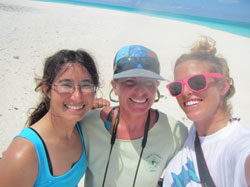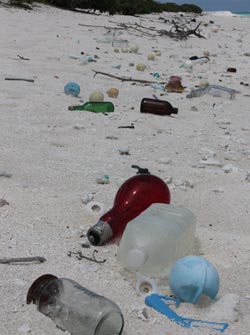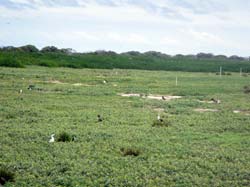
Reef Assessment and Monitoring Program Expediton Log – August 15, 2012
Exploring Green Island at Kure Atoll!
By: Megan Onuma & Carlie Wiener, COSEE Island Earth
Our long anticipated journey to Green Island finally arrived this week. In the early morning hours we sped out on the small boat, Malolo. After navigating through the coral-filled lagoon, using the landmark ironwood tree also known as the "navigation tree," we arrived at a thin patch of white sand. On this remote sand island clearer details come into view - monk seals sleeping on the beach, a lonely concrete pier, and dozens of seabirds weaving through the air. Julia Parrish, Kure Atoll field camp coordinator, stood waiting to greet us.
Kure Atoll is northernmost emergent feature of the entire Hawaiian Archipelago, and is the most northern coral atoll in the world. The 10 km atoll is made up of a circular reef crest, creating a lagoon with crystal clear blue waters, and several sand spits ideal for resting Hawaiian monk seals. Green Island, where we landed, is the largest landmass at Kure, and is managed by the State of Hawaiʻi's Department of Land and Natural Resources (DLNR), Division of Forestry and Wildlife.
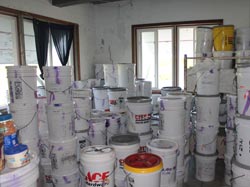
Hundreds of food containers that keep the volunteers nourished on this remote island for seven months of the year. Credit: C. Wiener
The first thing you must do when arriving on island, is change into pre-frozen quarantined clothing. This is a very important process, which helps to prevent the spread of new insects or plant seeds to this remote island; Kure does not have centipedes or mosquitoes and we wanted to keep it that way! Julia walked us back towards the two small buildings that make up base camp at Kure Atoll. These houses serve as the temporary homes for the four volunteers who are staying on island for seven months in order to help with the native plant restoration.
As we toured the land, Julia pointed out the native beach naupaka bushes growing lushly near the shore, part of an incredible restoration effort that she and the other island volunteers are doing. The entire island used to be covered by an invasive weed called Verbesina. This plant is able to spread itself quickly through its seeds, and its uncontrolled growth damages the habitat for the thousands of seabirds that live on Kure. Since 1993, a dedicated crew of DLNR technicians and volunteers has worked to restore these critical seabird habitats. They have cleared invasive (non-native) plants, and reintroduced native plants that allow the seabirds to lay their eggs, nest, and have their chics fledge the nests. The team also helps to band the seabirds, monitoring their populations, and doing marine debris surveys and removal. The manual labor of removing the weeds and out-planting native plants would exhaust anyone, yet these awe-inspiring workers labor around the clock and work under completely remote and isolated conditions.
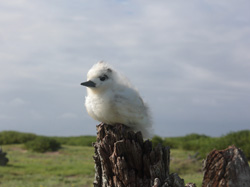
A Tern chick perches on a tree stump overlooking the newly restored native plant fields. Credit: C. Wiener
When talking to the volunteers, their motivating words echoed as we saw first-hand the impact of plastics even in this remote location. They spoke of how life on this tiny island had changed them for good. "Give up bottled water! And then, if you can, give up bottled everything," encouraged one of the volunteers. Julia echoed that sentiment: "Curb your use of plastic." These words come firsthand from people who have watched hundreds of birds die with stomachs full of plastic; however, their message is not one of gloom. They hope to inspire people by showing that big change is possible. Little by little, they're eradicating the invasive plants so that native species can take over. Now, there are seabirds nesting in the area once covered by the suffocating weed, so much so that they have renamed one of the areas "boobie acres".
Click here to go back to the Expedition Log.
